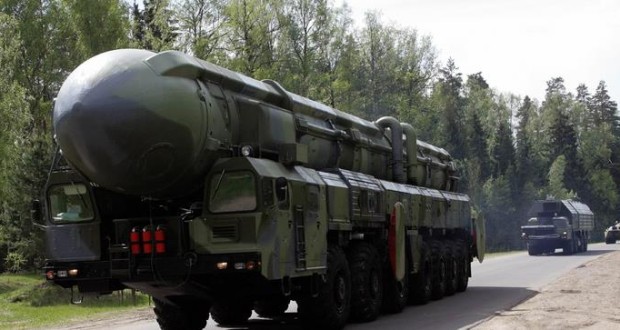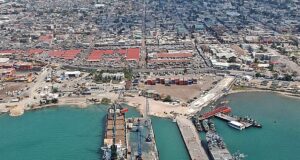October 7th, 2015
By Davis Florick – Junior Fellow
At a time when the nuclear non-proliferation community appears to be residing on unstable ground at best, Russia’s ambitious nuclear force modernization program seriously impugns the nuclear reductions momentum of the international regime. Whilst far from being the only one of the world’s nuclear powers to be recapitalizing its assets, the sheer scale of Moscow’s efforts with regards to its introduction of advanced systems marks the most substantial investment of any nation in its nuclear strike force since the end of the Cold War.
The Nuclear Non-Proliferation Treaty (NPT) and the advocacy program that has been built up around it has sought to discourage two developments: (a) horizontal proliferation (additional states acquiring nuclear weapons technology) and (b) vertical proliferation (increases in quantity or quality, or both, of the weapons possessed by existing nuclear states). Regrettably, Russia’s ambitious acquisition program and consequent capabilities upgrades almost certainly constitute a rejection of the NPT’s latter aspiration. The only saving grace, as of yet, is that the New Strategic Arms Reduction Treaty (New START) places a quantitative ceiling on Moscow’s strategic systems until 2021. Nevertheless, when considering the nuclear arms control accomplishments of the first two decades following the end of the Cold War, the current climate is placed in stark contrast. Arguably most troubling is the relatively minor attention Russia’s nuclear weapons development program has received in either Europe or the United States. From an international perspective, considerable utility can result from shedding light on the fast approaching modernizations to Moscow’s weapons of mass destruction. Only by further detailing Russia’s investments can the global security community come to appreciate the full impact these policy decisions will have on the non-proliferation architecture.
For the purposes of this review, Russia’s modernization can be evaluated by examining two main categories – strategic versus nonstrategic – and three subcategories within the larger strategic umbrella. The most easily comprehensible differentiation is amongst the three categories of strategic platforms. (In contrast to those three types of strategic systems, the fourth category, non-strategic weapon systems, requires a more comprehensive explanation.)
Conveniently, New START provides definitions for each of the three strategic delivery platforms. First, the air component centers on heavy bombers, which must have a range greater than 8,000 kilometers (km) to be counted as strategic nuclear assets. Second, the land element deals with intercontinental ballistic missiles (ICBM), which must have a range in excess of 5,500 km to fall into this category. Third, the sea discipline focuses on submarine-launched ballistic missile (SLBM) types with a range in excess of 600 km [i].
While nuclear weapons have been perceived mainly to carry value in holding strategic assets at risk, they have also presented utility operationally and, more specifically, on the battlefield. From the earliest days of the nuclear age, decision makers have explored the possibility of employing non-strategic capabilities on the frontlines or in small-scale activities. These systems, also referred to as tactical nuclear weapons, are not as clearly defined as are the strategic systems. However, they can generally be separated from the aforementioned strategic systems by delivery vehicle range, type of delivery platform, and yield of the warhead.
The air element of Russia’s strategic nuclear forces is significant due to its affordability and use as a flexible deterrent. The Kremlin has already begun development on an update to one of its current strategic bombers, the Tu-160, and the introduction of a new system, the PAK-DA. The updated Tu-160, referred to as the Tu-160M2, should be introduced by 2023. The operationalization of an improved, supersonic Tu-160 will provide a bridge to future bomber capabilities. Specifically, Russian emphasis on the Tu-160M2’s importance as a replacement is necessary because Moscow’s next generation bomber is facing procurement challenges stemming from declining oil prices, restrictions on imported materials, and aging Soviet-era infrastructure. These obstacles should not be discounted, but the Tupolev engineering firm’s fifth generation airframe, the PAK-DA, will represent a major qualitative departure from Russia’s current airframes. Its stealth capability will be the first of its kind for the Moscow leadership. Consequently, the PAK-DA will have an air defense penetrating capability that the current Tu-95 and Tu-160 do not enjoy. Additionally, the Russian armaments industry is working on new missiles capable of use on both the Tu-160M2 and PAK-DA, which would offer an improved standoff function. Other characteristics may be enhanced as well, but these are yet to be determined. These two new airframes will offer Moscow a more reliable and longer range strategic air leg which can make use of improved missile technology. Certainly, the new technologies offer greater penetration and standoff capabilities that exceed what Russia currently possesses.
Undoubtedly, of all the elements of Moscow’s nuclear arsenal, ICBMs have been the most noteworthy whether viewed historically, at present, or into the foreseeable future. Its current silo-based and road-mobile assets offer Russia tailorable and differentiated attributes in terms of warhead configuration and survivability that US policy makers have chosen to move away from. Arguably most disconcerting regarding Moscow’s future force structure is the continued use of both road-mobile and heavy silo-based systems. The additional possibility of a rail-mobile capability raises new challenges and poses yet another affront to the NPT regime. Predominately, Russia’s ballistic missile force is predicated upon the SS-27 delivery vehicle. In the last decade and a half, the SS-27 Mod 1, also commonly referred to as the Topol-M, has been deployed as a single warhead system, with a road-mobile and silo-based variant. The newer RS-24 Yars derivative, also known as the SS-27 Mod 2, is also both a road-mobile and silo-based ICBM, but designed to carry three to four nuclear warheads as part of a multiple independently targetable reentry vehicle (MIRV) capability. The RS-24 deployments started in 2010 and are planned to be fully operational by 2021. Furthermore, deployments for yet another variant of the SS-27, the RS-26, are likely to begin as early as 2016. It is unknown whether the RS-26 will be a single or multi-RV system, but it is smaller than its other SS-27 cousins, thereby offering it improved mobility on the ground and greater evasion characteristics after launch. Of note, experts believe the RS-26 may only have a range of 5,800 km – the significance of which will be elaborated upon further in the non-strategic section. With that being said, the primary significance of the new SS-27 family is the uniformity of design leading to a more efficient maintenance program, placing it in stark contrast to the plethora of systems the Soviet Union deployed.
But even with five SS-27 models in the future stockpile, perhaps the most significant near-term additions to the strategic land component are the Sarmat and potential rail-mobile systems. The Sarmat is a liquid-fueled, heavy ICBM that will replace the SS-18, a mid-Cold War vintage delivery vehicle, and is likely to be capable of carrying ten to fifteen warheads. Given the characteristics of the overall system, the Sarmat is likely to weigh one hundred tons. Due to the payload, the size of the missile will almost certainly require that it be a silo-only asset. However, Russia has also discussed plans for a new rail-launched ICBM. It bears repeating that the impact which sanctions and falling oil prices will have over the long term has yet to be determined. With that being said, if brought to fruition, a rail capability could blend some of the advantages of both road- and silo-based systems. It would improve survivability while carrying a more substantial payload, closer to the silo-based systems and more than the road-mobile platforms are capable of. The challenge with Russia’s potential fielding of the Sarmat and rail-based systems lies in their MIRV capabilities. Moscow would potentially have fewer missiles and launchers, yet in a crisis scenario it could upload a substantial number of additional warheads onto a smaller number of assets. Therefore, these systems only work to encourage vertical proliferation.
The next generation of Russia’s ballistic missile submarine (SSBN) force could offer the state a far more robust sea element than it has possessed in years. With the fall of the Soviet Union and extreme budget cuts, Moscow was forced to sacrifice its navy. Having allowed it to fall into disarray, the introduction of the Bulava SLBM onto Russia’s Borey-class SSBN’s changes planning factors for the better in the eyes of the regime’s senior leadership by giving a more reliable and robust naval option. With sixteen missiles per boat, and potentially moving from eight to twelve Borey-class SSBN’s by the 2020’s, the new Russian navy is a far cry from the bereft fleet of the early post-Cold War years. In keeping with the newfound emphasis on uniformity, the Bulava, also known as the SS-NX-30, is the sea-based variant of the SS-27 Mod 1. The system includes a MIRV capability that is likely to be able to lift six to ten warheads, depending upon defensive countermeasures, decoys, and so on. Recently, Russian media outlets reported that the first Borey-class SSBN, the Alexander Nevsky, will join the country’s Pacific Fleet by the end of the year. The likely improvements in reliability of both its SSBNs and SLBMs would lead one to believe that Russia could utilize these new systems far more effectively and flexibly than its older sea-based nuclear assets.
Today, despite modernizations in the strategic realm, Moscow’s compliance with New START remains consistent. Regrettably, the same cannot be said in the non-strategic realm. The 1980’s Intermediate-range Nuclear Forces (INF) Treaty was the hallmark accord for non-strategic nuclear weapons. The Treaty required that the US and Soviet Union, later Russia, eliminate their respective intermediate-range (1,000 – 5,500 km) and shorter-range (500 – 1,000 km) ground-based missiles. Notably, this treaty included both ballistic and cruise missile systems. Unfortunately, the US Department of State’s 2014 and 2015 Compliance Reports to Congress have indicated that Russia has violated the terms of the Treaty not to possess, produce, or flight-test a ground-launched cruise missile (GLCM) with a range capability of 500 km to 5,500 km, or to possess or produce launchers of such missiles [ii]. The introduction of new shorter range nuclear-capable missile systems poses an additional obstacle for Russia’s potential adversaries. Most grievously, its lack of accountability under New START allows Moscow to place these systems anywhere across its state with little knowledge from the outside. Equally problematic, the mixed deployment of conventional and non-conventional systems creates attributional problems in case of a launch event. To a lesser degree, the introduction of a system like the RS-26, with a range just past the 5,500 km distance needed to be New START compliant, raises questions over the likely target set such a system might suggest – namely that it is intended to be an intermediate range asset when fully loaded. Indeed, the modernization of Russia’s non-strategic nuclear weapons represents yet another example of its efforts to proliferate vertically.
The qualitative upgrades Moscow is undertaking to its nuclear forces symbolize a clear departure from the international community’s arms control efforts. Rather than working toward global nuclear reductions, Russia has contributed to instability in Eurasia by further complicating the strategic environment. Russia’s technological advancements and upgraded capabilities clearly demonstrate a rejection of the de-nuclearization goals expressed by the Obama Administration. Its air, ground, and sea strategic capabilities are advancing at an alarming rate. Similarly, its non-strategic systems are diversifying and complicating the decision space in the event of a potential crisis. How these weapons are to be deployed and utilized also creates considerable challenges to the global non-proliferation system. The Kremlin’s investment in its most dangerous weapons systems have largely gone unnoticed in the US and Western Europe, but the challenges posed by Russia’s nuclear modernization efforts may place the very future of the NPT in doubt.
[i] Department of State, “Protocol to the Treaty Between the United States of America and the Russian Federation on Measures for the Further Reduction and Limitation of Strategic Offensive Arms,” online via: http://www.state.gov/documents/organization/140047.pdf [ii] Department of State, “2015 Report on Adherence to and Compliance With Arms Control, Nonproliferation, and Disarmament Agreements and Commitments,” online via: http://www.state.gov/t/avc/rls/rpt/2015/243224.htm Human Security Centre Human Rights and International Security Research
Human Security Centre Human Rights and International Security Research




